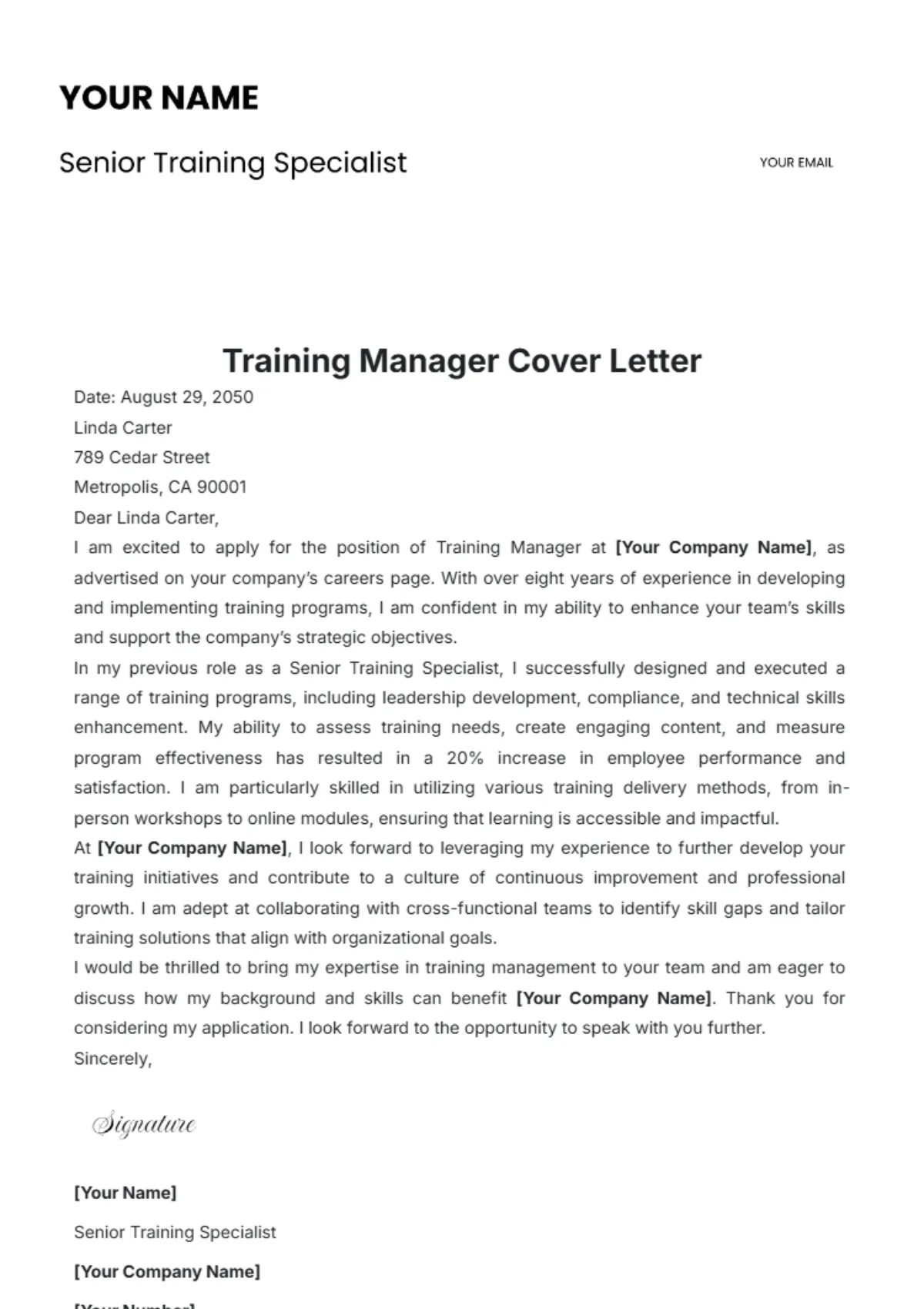What is a Training Manager?
A Training Manager is a pivotal role within organizations, responsible for developing, implementing, and evaluating training programs that enhance employee skills, knowledge, and performance. They serve as a bridge between the organization’s goals and the development needs of its workforce, ensuring that employees have the necessary skills to succeed. This includes identifying training needs, designing training materials, delivering training sessions, and assessing the effectiveness of training initiatives. Training managers often work closely with department heads and other stakeholders to align training programs with business objectives. The role demands a blend of instructional design expertise, communication skills, and a deep understanding of adult learning principles. They must be able to adapt to changing business needs and incorporate innovative training methods, such as e-learning, simulations, and on-the-job training. A successful Training Manager is instrumental in creating a learning culture that fosters employee growth and organizational success.
Key Responsibilities of a Training Manager
The responsibilities of a Training Manager are multifaceted, encompassing various aspects of employee development. Primary among these is conducting training needs assessments to identify skill gaps and performance deficiencies within the organization. Based on these assessments, Training Managers design and develop training programs, curricula, and materials that align with organizational goals. They also deliver training sessions, workshops, and seminars, utilizing diverse instructional methods to engage learners effectively. Another key responsibility is evaluating the effectiveness of training programs through assessments, feedback, and performance metrics. This involves analyzing data to identify areas for improvement and making adjustments to training programs accordingly. Furthermore, Training Managers often collaborate with subject matter experts to ensure the accuracy and relevance of training content. They also stay abreast of industry trends and advancements in training methodologies, integrating innovative approaches into their programs. Finally, they manage training budgets, resources, and schedules, ensuring the efficient and cost-effective delivery of training initiatives. The ability to manage these diverse responsibilities is essential for creating a skilled and productive workforce.
Why is a Cover Letter Important for Training Managers?
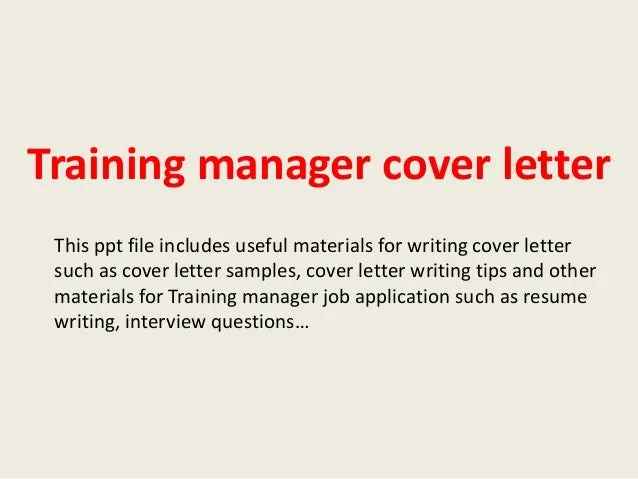
A cover letter is a crucial component of a Training Manager’s job application. It serves as your first introduction to a potential employer, providing an opportunity to showcase your personality, skills, and enthusiasm for the role. Unlike a resume, which provides a factual overview of your experience, a cover letter allows you to articulate your unique value proposition and explain why you are the ideal candidate. It is your chance to highlight specific achievements, demonstrate your understanding of the company’s needs, and express your passion for training and development. A well-crafted cover letter demonstrates your communication skills, attention to detail, and ability to tailor your message to a specific audience. It also allows you to address any potential concerns or gaps in your resume proactively. A cover letter is also an opportunity to show your understanding of the company’s needs and how your skills and experience align with the role. By providing a tailored cover letter, you can set yourself apart from other applicants, making a strong impression on the hiring manager and increasing your chances of landing an interview.
Essential Elements of a Training Manager Cover Letter
A compelling cover letter for a Training Manager should include several key elements. Start with a professional salutation, addressing the hiring manager by name if possible. In the opening paragraph, clearly state the position you are applying for and express your enthusiasm for the opportunity. The body of the letter should highlight your relevant skills, experience, and accomplishments. Focus on the training methodologies you’ve used, such as needs analysis, instructional design, and evaluation techniques. Provide specific examples of how you’ve improved training programs, increased employee performance, or reduced training costs. Demonstrate your understanding of adult learning principles and your ability to create engaging and effective training materials. In the closing paragraph, reiterate your interest in the position and express your eagerness to discuss your qualifications further in an interview. Always proofread your cover letter carefully for any errors in grammar or spelling. A well-structured and error-free cover letter shows your attention to detail and professionalism, making a positive first impression on the employer.
Highlighting Your Skills and Experience
When writing your cover letter, emphasize the skills and experience most relevant to the Training Manager role. Showcase your expertise in training needs analysis, instructional design, and curriculum development. Provide examples of training programs you have successfully designed and implemented. Highlight your experience with various training methodologies, such as e-learning, workshops, and on-the-job training. If you have experience with specific training software or platforms, be sure to mention them. Demonstrate your ability to evaluate training effectiveness using various metrics, such as participant feedback, performance data, and return on investment. Showcase your communication, interpersonal, and presentation skills, as these are crucial for delivering training sessions and working with stakeholders. Quantify your achievements whenever possible by providing specific data on how your training programs have improved employee performance, reduced costs, or increased efficiency. Tailor your cover letter to the specific requirements outlined in the job description to show that you understand the needs of the company.
Quantifying Achievements in Your Cover Letter
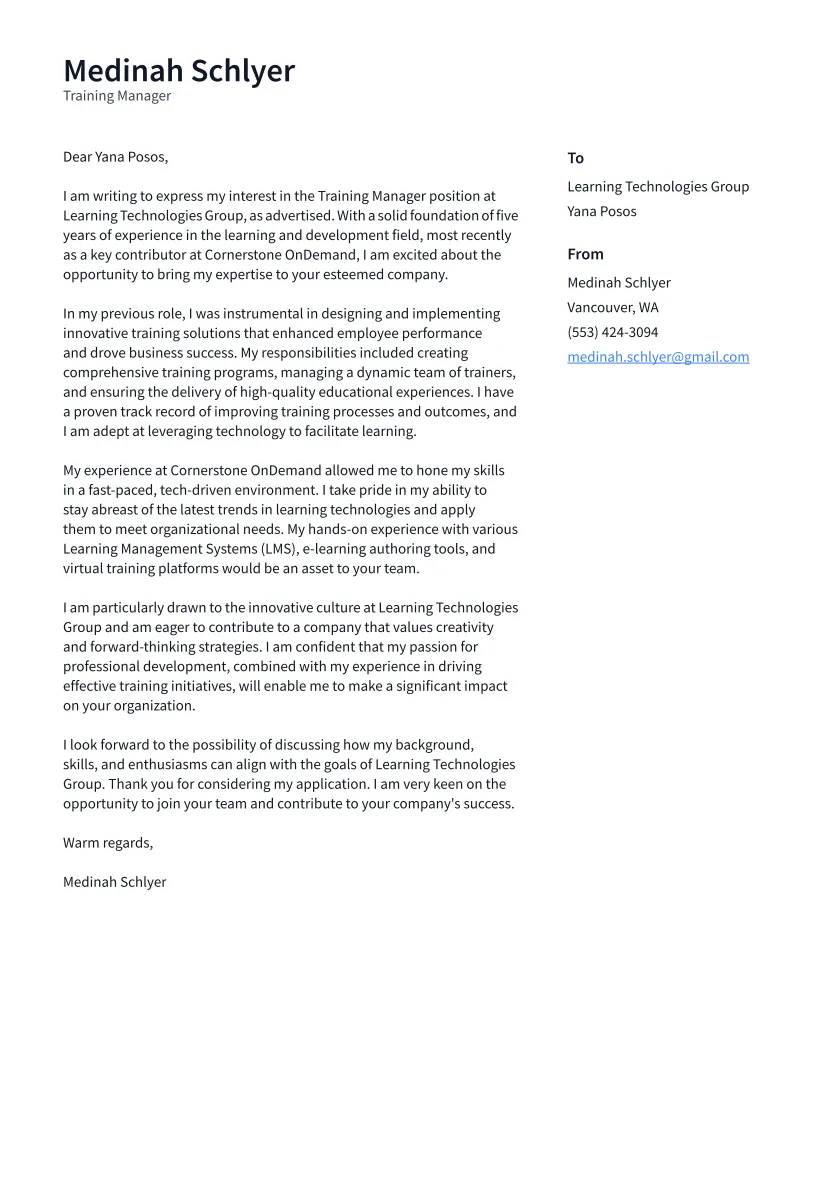
Quantifying your achievements is a highly effective way to demonstrate your value to potential employers. Instead of simply stating what you did, provide concrete examples of the results you achieved. For example, instead of saying “Improved training programs,” you could state “Redesigned the onboarding program, resulting in a 20% increase in new hire retention.” If you developed and delivered training programs, mention the number of employees trained, the reduction in errors, or the increase in productivity that resulted. If you managed training budgets, indicate how you reduced costs or improved resource allocation. When possible, include specific data points, such as percentages, dollar amounts, or measurable improvements in key performance indicators. For instance, “Increased employee engagement scores by 15% through the implementation of a new leadership development program.” Providing concrete evidence of your accomplishments demonstrates your ability to deliver results and makes a stronger impression on the hiring manager. Quantifiable achievements showcase your impact on previous employers and make a compelling case for your candidacy.
Showcasing Your Training Methodologies
Your cover letter should effectively showcase the training methodologies you are proficient in. Begin by mentioning your experience in conducting training needs analysis to identify skill gaps and performance deficiencies. Describe your expertise in instructional design, including the ability to develop engaging and effective training materials. Highlight your experience with various training delivery methods, such as classroom training, e-learning, blended learning, and on-the-job training. Showcase your proficiency in using different training tools and technologies, like Learning Management Systems (LMS), authoring tools, and presentation software. If you have experience with specific training frameworks or models, such as ADDIE or Bloom’s Taxonomy, mention them. Emphasize your ability to adapt your training methodologies to meet the specific needs of the audience and the organization. Finally, demonstrate your commitment to continuous improvement by highlighting your experience in evaluating training effectiveness and making adjustments based on feedback and performance metrics. Demonstrating your wide range of methodologies will give you a stronger advantage over other candidates.
Tailoring Your Cover Letter to the Job Description
Customizing your cover letter to align with the specific job description is crucial for making a strong impression on the hiring manager. Start by carefully reviewing the job posting and identifying the key requirements, skills, and qualifications the employer is seeking. Use the job description as a guide to tailor your cover letter, ensuring that you address the employer’s specific needs and priorities. Highlight the skills and experience that directly match the requirements outlined in the job description. Use keywords and phrases from the job posting to demonstrate your understanding of the role and the company’s needs. Provide specific examples of how you have demonstrated the required skills and achieved results in similar roles. Avoid using a generic cover letter; instead, customize it to showcase your unique qualifications and how you can contribute to the organization’s success. By tailoring your cover letter, you demonstrate your attention to detail, your genuine interest in the position, and your understanding of the company’s requirements. This targeted approach increases your chances of getting noticed and securing an interview.
Structuring Your Training Manager Cover Letter
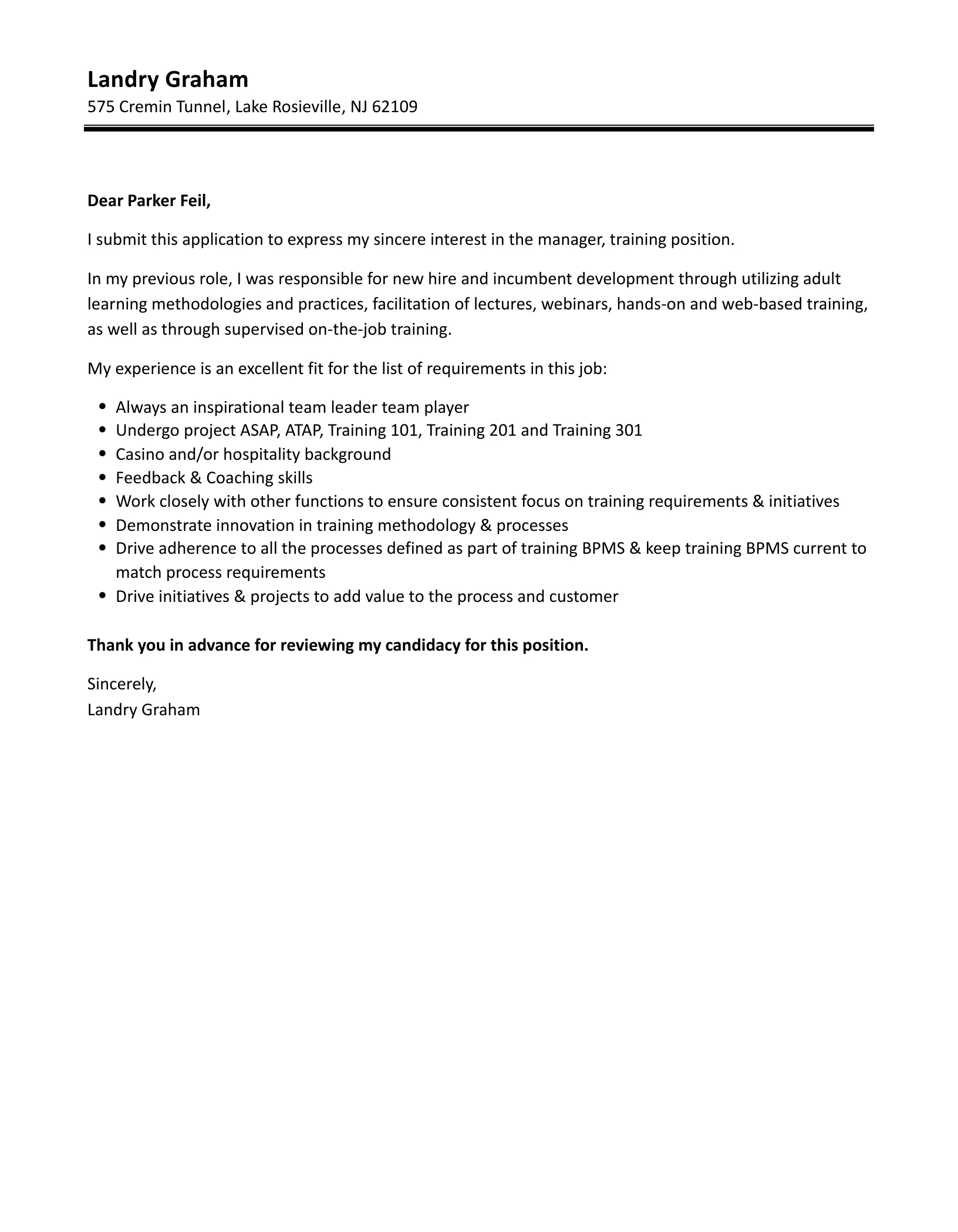
A well-structured cover letter enhances its readability and impact. Begin with a professional heading, including your contact information and the date. Address the hiring manager by name if possible; otherwise, use a professional salutation, such as “Dear Hiring Manager.” The opening paragraph should clearly state the position you are applying for and express your enthusiasm. In the body of the letter, use separate paragraphs to highlight your skills, experience, and achievements, focusing on the key requirements of the job. Use clear and concise language, avoiding jargon and technical terms that the hiring manager may not understand. Each paragraph should focus on a specific point, making it easy for the reader to follow your narrative. Use action verbs to describe your accomplishments and quantify your achievements whenever possible. In the closing paragraph, reiterate your interest in the position and thank the hiring manager for their time and consideration. End with a professional closing, such as “Sincerely” or “Best regards,” followed by your name. Proofread your cover letter carefully to ensure it is free of errors in grammar and spelling.
Proofreading and Formatting Your Cover Letter
Proofreading and formatting your cover letter are essential steps in ensuring it makes a positive impression. Before submitting your application, carefully proofread your cover letter for any errors in grammar, spelling, and punctuation. Read the letter aloud to catch any awkward phrasing or inconsistencies. Ask a friend or colleague to review your cover letter for clarity and accuracy. Pay close attention to the formatting of your cover letter. Use a professional font, such as Times New Roman or Arial, and maintain a consistent font size throughout the document. Use clear and concise formatting, such as bullet points, headings, and subheadings, to make your cover letter easy to read. Ensure that the margins are consistent and that the text is properly aligned. Use a standard business letter format, with a professional heading, salutation, body, and closing. A well-proofread and well-formatted cover letter demonstrates your attention to detail and professionalism, making a strong statement to the hiring manager.
Cover Letter Examples Training Manager Success
Reviewing successful cover letter examples for Training Managers can provide valuable insights and inspiration. Look for examples that effectively highlight skills, experience, and achievements relevant to the role. Pay attention to how the cover letter is structured, the language used, and the overall tone. Analyze how the applicants demonstrate their understanding of the company’s needs and tailor their cover letter to the specific job description. Note how they quantify their achievements using specific data and metrics. Study how they showcase their training methodologies and expertise. Analyze examples that use strong action verbs and focus on results. While using examples as a guide, avoid simply copying and pasting content. Instead, use them as a template to craft a cover letter that reflects your unique qualifications and experiences. Tailor your cover letter to match the specific requirements of the job you are applying for. By studying successful examples, you can gain valuable insights into what makes a compelling cover letter and increase your chances of securing an interview.
Finalizing Your Cover Letter
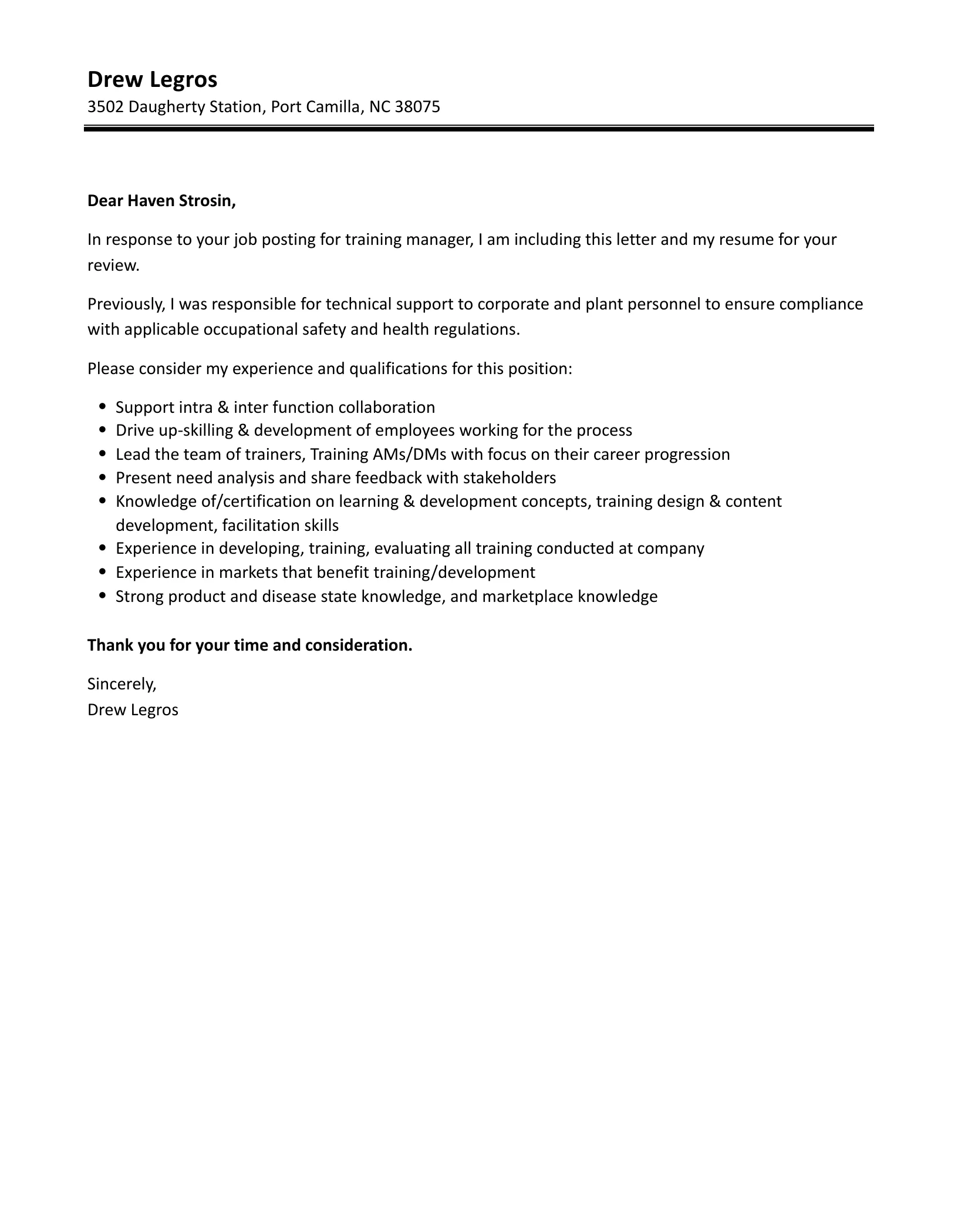
Before submitting your cover letter, take a final step to ensure it is polished and ready. Confirm that the letter is addressed to the correct person, and the company name and job title are accurate. Double-check all contact information to make sure that it is correct. Ensure that your cover letter is formatted professionally, using a readable font, appropriate margins, and consistent spacing. Verify that the language is clear, concise, and free of grammatical errors. Proofread the entire document one last time, paying close attention to detail. Once you are confident that your cover letter is error-free and effectively highlights your qualifications, save it as a PDF to preserve the formatting. Finally, submit your cover letter along with your resume, following the instructions provided in the job posting. By taking these final steps, you will increase your chances of making a strong impression and securing an interview for the Training Manager position.
